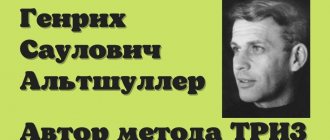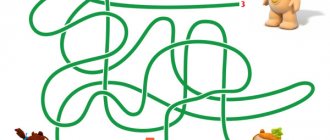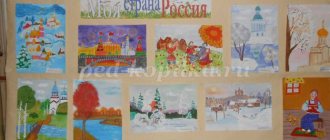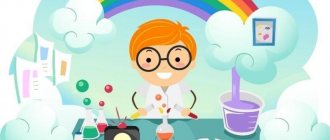In your opinion, at what age should children be introduced to the theory of solving inventive problems? While you are thinking, we will answer: from kindergarten. No, no, we are not talking about forcing preschoolers to take integrals or design 3D graphics. The point is to teach children to think creatively and find ways to solve problems that arise before them.
Agree, even the most loving and caring parents cannot give their children ready-made templates for solutions for all occasions. And not even because it is physically impossible, but because it is not necessary. A much more reasonable step would be to instill in children an algorithm for solving emerging problems and teach children to use it.
Our program “TRIZ in practice: a creative approach at work and in life” will help you with this. And, of course, our article about TRIZ methods for preschoolers, where we will look at the basics of this creative approach for the little ones who have already reached kindergarten, but who are too early for school. This is the most important stage, because it is during this period of life that children lay the foundations of thinking and the foundations for their future success in school and life.
What is TRIZ?
First, let's say a few words about what TRIZ is. The original idea of TRIZ is that different problems can often be solved using the same methods. The theory is based on several dozen ready-made techniques and solution templates, from which you need to select the most suitable ones for a specific task.
Initially, the posed problem is reduced to a certain general form, then a suitable technique is sought to solve it, and then the solution found is applied to the initially posed problem. At first, the theory was used to solve technical problems, but later it became clear that TRIZ could be applied to life and to solve a wide range of problems.
The very first version of the theory of solving inventive problems was developed by
Genrikh Saulovich Altshuller (1926-1998), known to science fiction fans under the pseudonym Genrikh Altov. Yes, he is not only an inventor, but also a talented writer, and his “Legends of Star Captains” and other works are loved by many generations of readers [G. Altov, 2015]. By the way, Heinrich Altshuller wrote a lot for children. Is this why the theory he invented for solving inventive problems is applicable even to kindergartens?
Heinrich Altshuller began developing the principles and methodology of TRIZ in the post-war years, then continued to work on the theory in collaboration with the inventor Rafael Borisovich Shapiro (1926-1993). By the way, Shapiro was also a writer and signed his works with the pseudonym Rafail Bakhtamov. It is significant that the very first publication devoted to TRIZ touched primarily on issues of the psychology of invention and was called “On the Psychology of Inventive Creativity” [G. Altshuller, R. Shapiro, 1956].
In the same article, an attempt was made to systematize the creative process, breaking it down into stages:
- Analytical stage – selection and definition of the fundamentals of the problem, identification of the main contradiction and its causes.
- The operational stage is the study of typical solutions in nature and technology, and the subsequent search for new methods within the system and beyond.
- The synthetic stage is the introduction of functionally determined changes to the system and methods of its use, checking the applicability of the principle to solving other problems.
The concepts, methods and solution schemes were presented in more detail in the book “Introduction to TRIZ”, which was subsequently republished many times. Basic concepts and approaches" [G. Altshuller, 2011]. Thus, the author of the theory believes that the first step to invention is the correct formulation of the situation so as to immediately exclude from consideration not very effective and not very promising solutions.
Next, you need to set the task in the format of “remove unnecessary quality without losing the functionality of the system” or “add the desired quality in addition to the existing ones.” This formulation of the problem allows us to answer a number of extremely important questions for subsequent work :
- What parts does the system have and how do they interact?
- Which parts and interactions are beneficial, which are harmful, and which are neutral?
- What can be changed without losing functionality, and what cannot?
- What will lead to improvement of system functions and what will lead to deterioration?
Then you need to identify contradictions on the way to solving all these issues and eliminate them. For example, to increase the strength of a structure without increasing the mass of the structure. Actually, after all this has been done, there is literally a step left before invention. The algorithm for solving inventive problems (abbreviated as ARIZ) developed by Heinrich Altshuller includes several dozen steps. The number of steps varies depending on the version of the algorithm.
How can all of the above be applied in kindergarten, when most children have just begun to memorize letters and numbers? Let's find out!
The task of TRIZ in the cognitive development of preschool children "LUNOKHOD"
A Lunokhod on large inflatable wheels was landed on the Earth's satellite, designed to study the surface and soil in detail. But the task was complicated by the fact that the gravitational force of the Moon is much less than on Earth, and any unevenness on the surface turned the Lunokhod on its side. The researchers weighed down the car with a load, hanging it under the body, but a new obstacle arose. When hills appeared on the way, the load clung to them and did not allow us to move further. Task: it is necessary to increase the cross-country ability of the Lunokhod without making fundamental changes to the design.
Solution : The first thing that comes to mind is to move the weighting material to the roof, or inside the cabin. But such actions will lead to a shift in the center of gravity, which will further affect the instability of the Lunokhod. As a result, the astronauts came up with the idea of distributing the load evenly across all wheels and placing it in the tires. This solution has already been used in practice. Japanese scientist P. Shoho proposed this option as applied to large trucks, cranes and loaders.
Why is the TRIZ methodology needed in kindergarten?
We all come from childhood, and the foundations of a person’s future life are laid precisely in preschool age. At this time, the little person learns to walk and talk, read and write, listen and understand, communicate and express emotions, and, of course, think.
Today, creative thinking is needed in almost any field of activity: law and software development, medicine and the construction of country cottages, pedagogy and even the installation of telecommunication networks, because communication means penetrate where nothing is suitable for their use.
How work with children in kindergarten is structured largely determines how creative thinking will be developed in children. And, therefore, how well they will study, how well they will choose a profession and how well they will be able to fit into the modern world. The objectives of the TRIZ methodology are precisely to teach a creative approach, and therefore are ideally suited for working with preschoolers.
Children are not yet constrained by perception patterns, they are inquisitive and spontaneous, they are just learning about this life. Therefore, nothing prevents them from imagining their imaginary world and deciding for themselves how they want to see it. Ideally, children should not only not be disturbed, but also indulge in every possible way their desire for creativity and learning everything new. The introduction of the TRIZ methodology in a preschool educational institution (preschool educational institution) contributes to the creative process to the fullest.
Let us note that creativity is not some separate process isolated from everything else. Creativity is directly related to the development of analytical thinking, observation, attentiveness, imagination, speech, and the acquisition of new sensorimotor skills. As a result, the ability to think creatively contributes to the formation of a multifaceted personality with a broad outlook and the ability to practically solve emerging problems.
Objectives of the TRIZ methodology:
- Development of creative perception and thinking.
- Development of the qualities of a creative personality.
- Formation of vocabulary.
- Development of coherent speech and the ability to express thoughts.
- Pronunciation correction.
- Formation of perception of numbers and mathematical concepts.
- Teaching constructive activities.
- Instilling socialization, interaction and teamwork skills.
Thus, the TRIZ methodology contributes not only to creativity itself. The TRIZ technique is no less useful in developing coherent speech, replenishing vocabulary, acquiring skills in operating numbers and mathematical concepts, and much more. It is probably easier to find what is not included in the tasks of the TRIZ methodology.
Therefore, the TRIZ methodology in kindergarten is needed, on the one hand, to develop flexibility and systematic thinking, and on the other hand, to stimulate search activity and the ability to find answers to non-standard questions. Using the TRIZ methodology, you can significantly activate a child’s creative potential, his mental activity and imagination, and raise a child into a real inventor and generator of new ideas.
And one more important point. A kindergarten, a group in a kindergarten, is a small group, but a team. And sometimes it’s not a small, but a fairly large children’s group. Group classes using the TRIZ method teach children cooperation, interaction, the ability to help a friend and find a way out of a difficult situation, as well as rejoice at their own and others’ successes when the problem is successfully solved.
The results will not take long to arrive. Parents and educators will soon see that the child’s drawings have become more diverse, artistic subjects are more complex, speech is more literate, and now the child assembles structures from Lego not only from the proposed pictures, but also by inventing his own figures.
In general, TRIZ is a useful technique for children in all respects. All that remains is to figure out how to apply such a complex technique as TRIZ for such young children as preschoolers.
Master class “Morphological analysis - a method for developing creative imagination”
Master class “Morphological analysis - a method for developing creative imagination”
Target:
dissemination of experience in the use of elements of TRIZ-RTV technologies in children of senior preschool age in visual arts classes for the development of their creative imagination
Tasks:
— to form teachers’ ideas about the use of the “Morphological Analysis” method in working with children to develop creative imagination.
— show by personal example the production and use of tables for morphological analysis.
Equipment:
pictures depicting animals, body parts, blank tables for morphological analysis, multimedia presentation, booklets, pencils, glue (for each participant).
Progress of the event
To be successful in the modern world, children need an active life position and the ability to solve problems. This means that the student must be able to work with information, understand current events and situations, be flexible to change, be able to quickly find the right solution and have strong and creative thinking.
Such problems are solved by RTV and TRIZ technologies and their non-standard methods. One of the effective methods for developing children's imagination is morphological analysis.
The essence of the method is that mental operations are based on combination and are carried out using a table where some indicators are set vertically and horizontally.
The intersection of the values of these indicators is the basis of analytical activity. In RTV and TRIZ methods, a separate morphological table is compiled for each creative task.
Using the table, children come up with new buildings, clothes, fantastic animals and birds, fairy-tale characters - anything!
But it is necessary to remember that any fantasy must be embodied in the form of drawings and applications, otherwise the child does not feel satisfied with the creative process and loses interest in it. It is very important for a child to see the result of his creativity, to realize that he created something himself, that he is the talented author of his work.
I consider the morphological table to be the most effective in my work, which I use in creative sketches with children. This table is convenient because the number of axes and parameters in it can be modified at will and depending on the object being created.
To make a table on the theme “Fantastic Animal” you will need:
- a table where, depending on the age of the students, 2-4 horizontal and vertical lines can be used;
- pictures of animals, their body parts;
- glue, scissors;
- pencils, watercolors for drawing.
On the horizontal axis we lay out pictures of animals in order: bear, hare, cat, fox. Then we place the animal body parts that we will combine on the vertical axis.
I suggest you draw the resulting animal.
Let me give you another example. Creative assignment on the theme “Fantasy House”. We set the parameters of the drawing vertically: shape, color, material.
Then we place options for parts of the house horizontally: windows, doors, chimney.
We randomly select one characteristic from each row and combine it.
The result is unusual, fantastic houses, with a sheet of paper instead of a door, a window and a chimney in the shape of an orange star.
Using the same principle, my students and I made drawings of an unusual plant and received funny cars and wonderful toys.
Compiled by Deputy Head M.A. Chubakova.
6
TRIZ methodology: implementation technologies
The essence of the TRIZ method for preschoolers is to draw the child’s attention to the features of the world around him, interesting phenomena and events, but at the same time not to give an exhaustive explanation and answer to all questions. In other words, you don’t need to give children ready-made recipes and solutions, you need to teach them to find answers on their own.
In this sense, TRIZ is quite rightly considered a “school of creative personality”, because TRIZ presupposes creativity in everything, from posing a question to ways of finding an answer. By the way, this is completely consistent with the concept of the great Russian teacher, psychologist and researcher Lev Vygotsky.
Thus, he explored the relationship between learning and development, thinking and speech, creativity and imagination, social environment and mental development. He introduced into scientific use the concept of the “zone of proximal development for children” and always insisted that learning is not the same as development. You can read more about his developments in this direction, in particular, in the book “Thinking and Speech” [L. Vygotsky, 1999].
Actually, the difference between TRIZ and traditional methods of working with children is precisely to give children the opportunity to think of things that are accessible to them with their own minds, and not just repeat what adults have said. Of course, such methods require special training on the part of preschool teachers.
At a minimum, they themselves should be able to see the unusual in the ordinary, the new in the familiar. And they must be able to show this new and unusual to children. How? For this purpose, there are special methods and technologies adapted to the characteristics of preschool age.
TRIZ methods for preschoolers are described in detail in the book “TRIZ Classes in Kindergarten (a manual for teachers of preschool institutions)” [P. Gin, 2010]. Options for applying these methods in practice can be found in the book “Development of Creative Thinking. Along the steps of TRIZ. First stage. Workbook" [E. Pchelkina, 2019].
Let’s say right away that in TRIZ methods for children we will see a lot in common with methods for stimulating creative activity and imagination in adults. The difference will only be in the specifics of the tasks that children face. All tasks are adapted taking into account the age and perception of preschoolers, and the teacher acts as a moderator of the discussion. So let's see how it works!
Brainstorming method
The brainstorming technique is that children are given a problem and asked to find a solution, and they are allowed to put forward any, even the most unrealistic, versions of the solution. Any criticism of the ideas put forward is prohibited, both from adults and from group mates in the kindergarten. You can only complement and offer improvements to other people's ideas. Tasks for brainstorming are chosen from among those understandable to children:
- How to save your grandmother from a gray wolf.
- How to put out a fire without water.
- Where to hide from the heat in summer.
When a lot of ideas accumulate, the discussion participants all together choose the best option.
Method of morphological analysis
The essence of the method is to try to combine different characteristics of an object when creating a new object. Let's say, if you need to invent a new game, for clarity, two axes are drawn. Along one they draw the parts of the body that will be involved in the game (arms, legs, arms + legs), and along the other are the playing devices that can be used (ball, tennis racket, jump rope).
Next, the whole team goes through possible options for combining and using body parts and gaming devices in the game, and at the end, you can invite everyone to play together a new game that the children have just come up with. Such games using the TRIZ method greatly develop fantasy, imagination, and the ability to interact. This is a simple example, but in principle, using the method of morphological analysis, you can invent much more complex things and find dozens of variations of a future invention.
Focal object method
This method assumes, to some extent, the opposite situation: you need to transfer the properties of one object to another. The simplest example: imagine and draw what a dog with wings, a bird with horns, or a waterfowling camel might look like.
In a similar way, you can try to “create” a hybrid of a ship and an airplane, a train and a submarine, a car and a helicopter. The main thing is not to limit children's imagination in anything! In this regard, the focal object method is ideal specifically for children, because its application possibilities are limited for complex technical solutions.
Directory method
The essence of the method is to arrange events in a logical sequence and come up with connections and transitions between them. In this way, for example, you can compose a new fairy tale. The teacher gives hints in the form of pictures and leading questions:
- Who is our main character in the fairy tale?
- Is this hero positive or negative?
- Why is this hero positive or negative?
- What bad did the bad guy do?
- What good did the positive hero do?
- How did they fight each other?
- Who supported the negative hero?
- Who supported the positive hero?
- How did the confrontation between good and evil end?
In addition to imagination, this TRIZ technique is useful in developing coherent speech, public speaking skills and expanding vocabulary.
Personal analogy method
As part of this method, children are asked to personally depict any animal, phenomenon, or object. You should start with simple tasks. Let's say, depict a cat or a dog, show how the cat or dog is angry, happy, asking for food.
Afterwards you can move on to more difficult tasks. For example, depict rain, a thunderstorm, snowfall, a storm at sea, a boiling kettle, or a working vacuum cleaner. Then you can further complicate the task. For example, ask the children to imagine how a cat or dog would sing the song “A Christmas Tree Was Born in the Forest.” Or choose a suitable song for the “singing vacuum cleaner”.
Little People Modeling Method
The little people technique in TRIZ is a simplified and accessible for children version of the structure of the surrounding world from three types of little people: “hydratics”, “tverdikov”, “pneumatics”. Solid objects seem to be made of “tverdik”, and the “tverdik” stand close to each other and hold hands tightly.
By analogy, liquids seem to consist of “hydratics”, because “hydratics” do not hold hands and can move relative to each other. But “pneumatics” are constantly in motion, so we cannot see air, gas and other gaseous substances with our own eyes.
To begin with, children are explained the structure of solid, liquid and gaseous objects separately, and only then in connection and interaction. For example, iced tea is in a solid cup made of “hards”, and itself consists of “hydrates”. If the tea is hot, steam from the “pneumatics” rises above it.
In a similar way, it can be explained why you can easily remove a spoon from a cup of tea by picking it up, but you cannot pick up water from a cup. If we imagine that a spoon consists of several “tverdiki” that hold hands tightly, then, by taking and lifting one “tverdik”, we lift all the others with it. And water consists of many “hydratics” that do not hold hands. Therefore, taking one “hydratic”, we can only pull it out of the cup, that is, only a drop of water.
Methodology of typical fantasy techniques
The method of standard fantasy techniques (TFT) involves changing the properties of an object using magic. The Wizard of Increase, the Wizard of Decrease, the Wizards of Division and Union, and also the Wizards who can take us to the past or future come to the aid of children.
Children need to imagine what will happen if this or that object is enlarged, reduced, divided into parts, or transferred to another era. Examples of practical tasks can be found in the report “Methodology of typical fantasy techniques (TPF)”, made specifically for teachers working with young children [L. Mikhailina, 2016]. By the way, this technique is suitable not only for kindergartens. This TRIZ technique is also used in elementary schools.
Goldfish method
The Goldfish Method consists of dividing a situation into its component elements, evaluating the elements as real or fantastic, and finding a rationale for elements that seem impossible and fantastic. This method was named according to the plot of a well-known fairy tale, and it is easiest to consider the application of the method using the example of a fairy tale about a goldfish.
Children are offered a line-by-line analysis of the work with a rating on the “real - fantastic” scale. So, the first few lines look quite real. The old man could really live with his old woman on the seashore, and indeed, instead of fish, with a net you can pull out both algae and mud. Fantasy begins from the moment when a goldfish falls into the net.
Can a fish be gold? Here the children are invited to find an explanation for this phenomenon. For example, fish scales sparkled in the rays of the sun and therefore seemed golden. Or the sea was distant and southern, where fish of the most bizarre colors are found. This is how children find reasons for phenomena that are incomprehensible and unreal at first glance. Therefore, the “Goldfish” method is often called the method of substantiating new ideas.
Snowball method
The Snowball method is the exact opposite of the Goldfish method. It is based on the assumption of a certain fantastic situation, on which, like a rolling snowball, very real events are layered. A classic use of this technique is the story “Amphibian Man” by Alexander Belyaev.
The initially unrealistic fantastic idea that gills were implanted into a person to breathe under water is superimposed on other, very real events from people’s lives. By the way, the “Snowball” method is most often used for writing fairy tales. And, using this method, it is quite possible to teach children to compose fairy tales on their own.
These are the most basic and most popular TRIZ techniques for preschoolers. You will find more methodological developments in the article “Conducting classes using TRIZ technology in kindergarten” [N. Fominykh, 2017].
We already foresee that some readers are ready to begin making skeptical remarks about the authors of the methodology and assumptions that the authors themselves did not work in kindergarten and have never seen living children. And they don’t know that even the most inquisitive and good-natured baby can in the blink of an eye turn into an angry, withdrawn creature who will answer all the adults’ questions by remaining silent or answering with a monosyllabic “I don’t know.” What to do in this case?
Development of creative imagination in preschool children
The use of TRIZ in a preschool institution radically changes the teacher’s teaching style, liberates children, teaches them to think, analyze, look for options and make independent decisions.
TRIZ in preschool pedagogy offers many options for game tasks of various directions. Using the TRIZ method for preschoolers, you can actively influence the development of speech. Develop musical and artistic abilities. Instill a love of nature and instill a sense of empathy in children.
Today we will talk about the development of mathematical abilities, which every child has, but is not activated in every brain. Let's consider several game TRIZ tasks for preschoolers, including logical thinking.
What if the child answers “I don’t know”?
In fact, those who work using the TRIZ method are faced with a variety of situations, including childish stubbornness, reluctance to make contact, and getting involved in games using the TRIZ method. And we have already prepared recommendations for you on what to do in these cases [K. Nesyutina, 2014]. As a rule, such situations happen due to shortcomings on the part of adults. If desired, such situations are completely correctable, and over time, you can ensure that, upon hearing a question, the child begins to think about the answer, and not just remain silent or say “I don’t know.”
What to do to get your child to start thinking and reasoning:
- Never scold children for giving the wrong answer! Very often, “playing the silent game” is a consequence of the fact that the child has already said or done something wrong, received a bunch of comments, and is now simply afraid of making a mistake again.
- Reason with your child and don’t act like an examiner or a know-it-all. Children are acutely aware of falsehood, and if the child is already accustomed to the fact that you always know the correct answer and ask questions only for the purpose of testing, he may not want to be a test subject. Especially if, in case of an incorrect answer, he will also be scolded.
- Ask so-called “open” questions, for which there cannot initially be one single correct answer. This will make it easier for you to reason with your child, and the child will not be afraid to make mistakes. At the same time, he will understand that a different opinion is not necessarily wrong.
- Answer the questions your children ask you. Otherwise, children will quickly learn that they don’t have to answer or answer all “Whys” with “Because it ends in “y.” As a rule, children pick up such excuses from adults.
We wish that your children are healthy and happy, and that you always find a common language with them! We remind you that our program “TRIZ in practice: a creative approach at work and in life” and a screening test on the topic of the article are waiting for you:
We also recommend reading:
- Storytelling
- Creativity Development Digest
- Good books for self-education
- Invention: a selection of useful materials
- A selection of useful materials about creativity and creativity development
- TRIZ and design thinking in everyday life
- Secrets of inventors: a selection of useful materials
- TRIZ fairy tales in pedagogy
- TRIZ, RTV and TRTL in practice: dealing with the Soviet intellectual past
- TRIZ classes for children: raising geniuses and simply happy people!
- Charette procedure
Key words:1TRIZ






